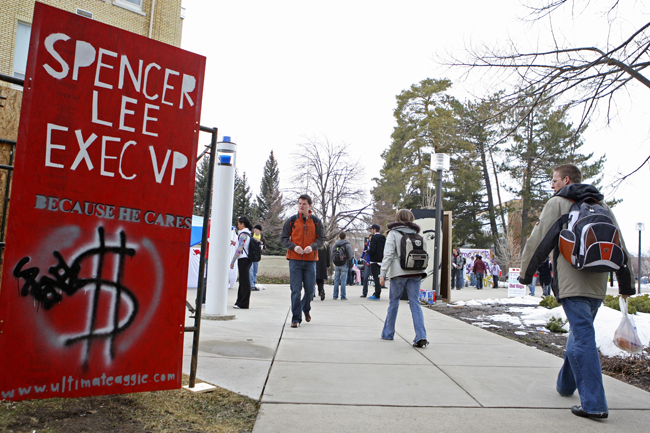ASUSU campaigns bylaws change
ASUSU candidates can now use multimedia, such as text messaging and the Internet, to campaign, something ASUSU hasn’t allowed in recent elections, said Bill Munns, ASUSU administrative assistant.
Multimedia had been allowed in the past but only for contacting people involved in campaigning efforts, Munns said. Just like with other forms of advertising, Munns said this year candidates weren’t allowed to start using multimedia communication until 7 a.m Wednesday.
Jonathon Kidd, member of the ASUSU elections committee, said it was hard to regulate multimedia campaigning, especially text messages, in the past because of the nature of technology. Candidates who use Facebook to get their faces seen are not allowed to use pages of third parties – pages that were in existence before the date campaigning was allowed to start.
This year each candidate is only allowed three grievances, or “tattles,” filed against them when they break campaigning rules before they are kicked out of the election, Kidd said. This has meant a cleaner campaign than in the past because candidates are forced to take more responsibility, he said.
Munns said the ASUSU bylaws were altered before this year’s election to include a definition of active and passive campaigning. He said the bylaws are reviewed and revised every year and then the executive council votes on whether to approve the changes or not.
Information provided by Alan Dangerfield, member of the elections committee, defined active campaigning as public, verbal advocacy of candidates, the distribution of campaign materials and the posting of campaign signs or fliers. It stated passive campaigning included wearing clothing, buttons, etc., that advertised a candidate or platform and any other campaigining not defined as active.
Munns said this year candidates are allowed to passively campaign at events such as the Aggie basketball game, something that wasn’t permitted before. He also said now that Facebook is a permitted form of campaigning, it is being widely and creatively used.
Jake Cook, presidential candidate, said he thinks technology is an important means of communication and USU is doing its students a service by allowing its use during the election.
“Other universities do it; we’re just behind the times,” he said.
To avoid creating spam, Cook said candidates are only allowed to send multimedia alerts to phone numbers and people they already know. Cook said he thinks allowing the use of Facebook as a campaign interface will help students get acquainted with candidates and their policies.
“Think about it. How many times does the average student get on Facebook in a single day?” he said.
Chris Barney, president candidate, said he put up his Facebook group at the earliest time ASUSU hopefuls were allowed to begin campaigning Wednesday morning. Barney said his site includes his platform so visitors can see what he’s about. He said he hopes to bolster support through Facebook like President Barack Obama did in his campaign.
Josie Olsen, HASS senator candidate, said she feels the Internet is the smartest way to campaign. She said she uses webisodes – short videos aimed at allowing the students to get a closer look at what Olsen believes and how she gets things done. So far Olsen said she has created two webisodes. The first one was about her platform and the second one showed her talking to her local sponsors.
“It’s a jungle,” Olsen said of the ASUSU elections. “It’s crazy because there are so many messages coming at you.”
She said multimedia messages such as videos, Facebook and blogs allow students to make sense out of the different messages candidates are feeding students. She said students can look at a person’s Facebook profile picture and see the groups they’ve joined to get a better feel of what that person is really like.
Josh Nagao, presidential candidate, said he has already received ten invitations to Facebook groups from other candidates. Instead of creating a group of his own, Nagao said he sought to distinguish himself from his running mates by creating his unique way of utilizing Facebook. Nagao said he posted his campaign picture and tagged his friends in it so when they get on Facebook they’ll see his campaign slogan. This way, his friends’ friends will also see his name and picture, he said.
Trevor Nelson, candidate for executive vice president, has a Facebook group for his campaign but said he doesn’t know if it will help him much in the election. He said there is only a short amount of time between when candidates are allowed to start campaigning and when elections are held, which doesn’t give much time for the group to circulate and collect members.
Nelson said he hasn’t joined any of his peers’ Facebook groups. In fact, he said he didn’t invite anyone who was running to join his group because there are already a lot of similar groups for other candidates.
Tyler Haws, candidate for student advocate, said as of Thursday morning his Facebook campaign group had around 130 members. However, Haws said he sees it as just another advertising tool and isn’t sure these groups will really help much in the election.
“Clicking to join a group is different than clicking to vote,” he said.
Whether the new multimedia campaign interface will help candidates or not isn’t certain and can’t be until the elections.
“I guess we’ll find out,” Haws said.
–rac.ch@aggiemail.usu.edu
all across campus, students campaign for various offices as the ASUSU student body elections draw near. This year candidates can expand their campaigns to include multimedia, such as text messages and Facebook. CAMERON PETERSON photos

